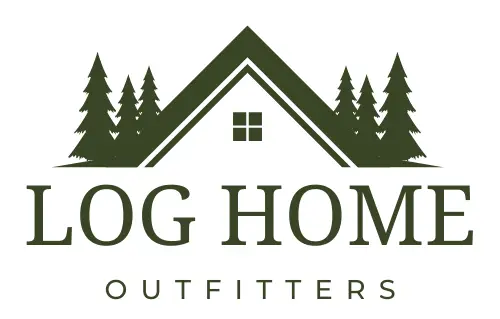I’m excited to share with you some of the essential tips for maintaining the beauty and integrity of your log home. Caring for a log home is a little different than taking care of a typical house, and if done correctly, it can last for generations.
I’ve over a decade of expertise in sustaining log home, and I’ve seen my justifiable share of issues. Log home are lovely, however they require a sure stage of upkeep to remain that method. Failing to care for your log home can lead to costly repairs, damage, and even structural problems. However, with the right approach, caring for a log home can be straightforward and even enjoyable.
First, let’s talk about the problems that log homes can face. The most common issues include rot, insect infestations, and water damage. Moisture is a significant threat to log homes, and it can lead to rot and decay over time.
Equally, insect infestations could cause intensive damage, and it is essential to maintain a watch out for indicators of pests. Finally, log homes are susceptible to water damage, especially if the logs are not appropriately sealed.
To prevent these problems, regular maintenance is necessary. Listed below are a few of the steps you may take to care to your log home:
Tip 1:
House Usually Inspecting your log dwelling frequently is crucial to forestall issues earlier than they turn into severe.
Stroll round your property and verify for indicators of injury, reminiscent of cracks or gaps within the logs.
Search for indicators of insect infestations, reminiscent of small holes or sawdust.
Finally, check the roof and gutters to ensure they are in good condition and not allowing water to collect on or near the logs.
Tip 2: Clean Your Log Home Cleaning your log home can help prevent damage caused by dirt, debris, and mold. Use a soft-bristled brush or a pressure washer to clean the logs gently.
Watch out to not use an excessive amount of strain or abrasive supplies that may harm the wooden.
Tip 3: Stain or Seal Your Log Home Staining or sealing your log home can help protect it from moisture and UV damage. It’s essential to choose a product that is specifically designed for log homes, as regular wood sealers or stains can harm the wood.
A good quality sealant or stain should be applied every three to five years, or as needed.
Tip 4: Monitor Your Log Home’s Moisture Ranges Moisture is a big risk to log houses, and it is essential to regulate the humidity ranges in your house.. Use a dehumidifier to maintain the air dry, particularly in humid climates.
Monitor the moisture levels in your logs with a moisture meter, which can help you identify potential problems early on.
Tip 5: Hire a Professional While some log home maintenance can be done yourself, it’s always a good idea to hire a professional for more complex issues. A log home specialist can identify potential problems and recommend the best course of action.
Tip 6: Maintain the Landscaping Around Your Home
Landscaping can have a significant impact on your log home’s health. Hold timber, bushes, and different vegetation away from the logs to stop moisture build-up and bug infestations.
Clear any dead or decaying vegetation from around the home, and ensure that the ground around the foundation slopes away from the house to prevent water from collecting near the logs.
Tip 7: Regularly Check the Chimney and Fireplace
If your log home has a chimney and fireplace, it’s essential to inspect and maintain them regularly.
Check for cracks or damage in the chimney, and clean the chimney and fireplace annually to prevent fires and carbon monoxide buildup. Hire a professional chimney sweep to ensure that everything is in good working order.
Tip 8: Repair Any Damage Immediately
Ignoring even minor damage can result in extra vital issues over time, so it is important to deal with any points as quickly as attainable.For those who discover any indicators of harm, resembling cracks or gaps within the logs, insect infestations, or water injury, restore them instantly
Tip 9: Educate Yourself on Log Home Maintenance
Educating yourself on log home maintenance is critical. There are many assets out there on-line, together with boards, blogs, and articles, that may give you useful data and recommendations on how you can care in your log house. Joining a local log home association or community can also be a great way to connect with other log home owners and learn from their experiences.
Tip 10: Keep the Interior of Your Home Well-Ventilated
Moisture can accumulate inside your house, in addition to exterior, which might result in harm and mould progress.
Make sure that your house is well-ventilated by utilizing exhaust followers within the kitchen and bogs, opening home windows often, and utilizing a dehumidifier if obligatory.
How often do you have to seal a log home?
I’m often asked about how often one should seal their log home.
As somebody who has labored with log houses for a number of years, I can inform you that sealing your log house is essential for sustaining its magnificence and longevity.
In the case of sealing a log dwelling, there are a number of components that come into play, such because the local weather, the age of the house, and the kind of sealant used. In general, it is recommended to seal your log home every 3-5 years, although this can vary depending on the aforementioned factors.
One of the main reasons why log homes need to be sealed regularly is to protect them from the elements.
Log homes are notably susceptible to moisture, which may trigger the wooden to rot and decay over time. That is very true in humid climates or areas that obtain a variety of rain or snow.
Another reason why log homes need to be sealed is to protect them from pests. Termites and other wood-boring insects can cause significant damage to log homes, and sealing the wood can help prevent them from gaining access.
In my experience, one of the biggest challenges with sealing log homes is ensuring that the sealant is applied correctly. Log homes have plenty of nooks and crannies, and it may be simple to overlook spots or apply an excessive amount of sealant in sure areas. This can lead to uneven coloring and a less-than-professional appearance.
To overcome these challenges, it’s important to hire a professional who has experience in sealing log homes. They will know the proper techniques for applying sealant and can ensure that the job is done correctly.
Here’s a real-life example of a log home that I worked on recently. The home was located in a humid area and had not been sealed in several years. Consequently, the wooden was starting to point out indicators of rot and decay, and there have been additionally some areas the place pests had gained entry.
We started by pressure washing the exterior of the home to remove any dirt and grime. Then, we utilized a high-quality sealant to your entire exterior of the house, ensuring to use it evenly and completely. Finally, we inspected the home for any areas that may have been missed and applied additional sealant as needed.
Overall, the project was a success and the log home now looks beautiful and is protected from the elements and pests.
What kind of maintenance does a log home need?
Sustaining a log residence requires a bit extra effort than sustaining a standard residence, however with the suitable data and instruments, it is a manageable job.
First and foremost, a log home requires regular cleaning. Dust, pollen, and different particles can accumulate on the floor of the logs, which might result in staining and discoloration over time.. Regular cleaning with a pressure washer or soft-bristled brush can help keep your log home looking its best.
Log homes also need to be sealed periodically to protect the wood from moisture, pests, and UV rays. The frequency of sealing is determined by a number of components, together with the local weather, the age of the house, and the kind of sealant used. As a common rule of thumb, log houses must be sealed each 3-5 years, however it’s essential to seek the advice of with knowledgeable to find out the most effective upkeep schedule to your particular house.
Another important aspect of log home maintenance is checking for and repairing any damage to the logs. This can include checking for cracks, rot, or insect damage. Regular inspections can help identify any potential issues before they become major problems.
In my experience, one of the biggest challenges with maintaining a log home is ensuring that the logs remain dry. Moisture is one of the biggest enemies of log homes, and if left unchecked, it can lead to rot, decay, and insect infestations.
To mitigate this threat, it is essential to maintain gutters and downspouts clear and in good working order, in addition to making certain that the roof is in good situation. Properly grading the land around the home can also help prevent moisture from seeping into the foundation.
Are log cabins expensive to maintain?
one of the most common questions I receive is whether log cabins are expensive to maintain. The reply to this query relies on a number of elements, together with the age of the cabin, the kind of wooden used, and the extent of maintenance.
In my experience, log cabins can be more expensive to maintain than traditional homes. This is because log cabins require specialized maintenance to protect the wood from moisture, insects, and other environmental factors.
One of the biggest factors contributing to the cost of log cabin maintenance is the need for regular sealing. Sealing the logs helps protect them from moisture, which can lead to rot, decay, and insect infestations. Relying on the kind of sealant used, the dimensions of the cabin, and different elements, sealing a log cabin can value a number of thousand dollars.
Another cost factor is the need for regular cleaning. Logs can accumulate grime, pollen, and different particles over time, which may result in staining and discoloration. Regular cleaning with a pressure washer or soft-bristled brush can help keep the logs looking their best, but it can also add to the overall maintenance costs.
In addition to these costs, log cabins may require repairs or replacement of damaged logs. Cracks, rot, or insect damage can all compromise the structural integrity of the cabin and must be addressed promptly to prevent further damage.
That being said, the cost of log cabin maintenance can be managed with proper planning and upkeep. Regular inspections, cleaning, and sealing can help prevent major issues and prolong the lifespan of the cabin.
Read Also:
- How to Pair Rugs in Open Floor Plans: Step Up Your Design Game, 2023 Guide
- How to Draw Door in Floor Plan: Step-by-Step Guide 2023
Final Verdict
In conclusion, caring for a log home requires regular maintenance and attention, but it’s well worth the effort. By following these ten essential steps, you can ensure that your log home remains beautiful and structurally sound for years to come.
Remember to inspect your home regularly, clean it, stain or seal it, monitor moisture levels, hire professionals when needed, maintain the landscaping, check the chimney and fireplace, keep the interior well-ventilated, repair any damage immediately, and educate yourself on log home maintenance.
FAQs
How do I keep my log home dry?
Moisture is one of the biggest enemies of log homes, and keeping the logs dry is critical to preventing rot, decay, and insect infestations. Proper grading of the land around the home can help prevent moisture from seeping into the foundation.
Keeping gutters and downspouts clean and in good working order is also important, as is ensuring that the roof is in good condition. Additionally, sealing the logs and regularly inspecting them for any damage can help keep them dry and in good condition.
How can I protect my log home from pests?
Log homes are significantly vulnerable to insect infestations, and stopping pests from coming into the house is important to sustaining its structural integrity.
Probably the greatest methods to guard a log home from pests is to make sure that the logs are correctly sealed, which can assist forestall bugs from burrowing into the wooden.
Regular inspections can help identify any signs of pest activity, such as sawdust or holes, and prompt action can prevent further damage. Moreover, conserving the realm across the dwelling freed from particles, equivalent to firewood or different logs, can assist cut back the chance of pest infestations.
Can I clean my log home myself, or do I need to hire a professional?
Cleaning a log home can be a DIY project, but it’s important to use the right techniques and products to avoid damaging the wood.
Soft-bristled brushes and pressure washers can be used to remove dirt and debris, but care must be taken to avoid damaging the logs or forcing water into gaps between them.
It’s also important to use the right cleaning products, as harsh chemicals can strip the protective coating from the logs.
Should you’re not comfy cleansing your log home yourself, or when you’ve got a big or multi-story house, it might be finest to rent an expert log home upkeep firm.




